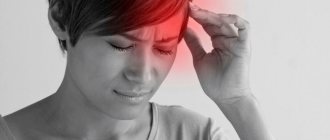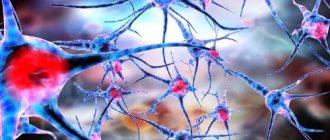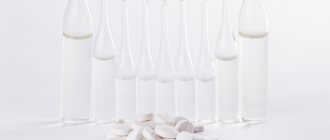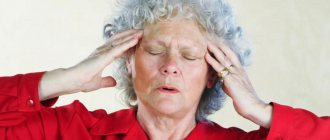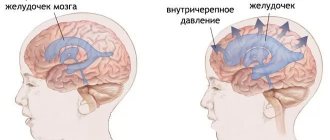Chronic headache is the name used in medical practice for systematic pain in the back of the head and temples for two or more weeks. It comes in several types: chronic migraine, abusive pain and others.
Cephalgia (headache) can bother you for several months in a row, severely exhausting the body: weakness, depression, fatigue, apathy, insomnia, etc. appear. Every 20th patient experiences this disease, and in women the symptoms appear more often.
Symptoms of chronic headache
Chronic cephalgia can manifest itself in the form of acute or dull pain. The duration of attacks differs among different types of chronic headaches (less or more than four hours daily).
Main symptoms:
- Transformed migraine is a unilateral headache with a throbbing sensation that occurs daily for more than 15 days in a row. The pain syndrome is severe and prolonged, interfering with physical activity. The person may experience nausea and vomiting. During the period of painful exacerbation, the patient reacts painfully to bright lights and sounds.
- Tension headache - a feeling of pressure appears, as if wearing a hat two sizes too small or squeezing the head with a belt. Bilateral pain is usually moderate, sometimes intense. During an attack, the patient becomes hypersensitive to loud sounds.
- Cluster headache is a condition that occurs more often in men and is quite rare. The main symptoms include a sudden, severe headache. It is usually felt in the temples or at eye level, less often in the neck and sides of the head. The pain is one-sided and can last up to three hours. During an attack, patients experience irritability, anxiety, and photophobia.
- Overuse headache - progresses in people who abuse painkillers to combat migraines and other ailments. This condition can be avoided if you do not self-medicate with over-the-counter medications. Overuse headaches can be provoked by systematic (more than 9 days in a row) use of triptans, narcotic analgesics and combination drugs.
In order to prescribe the correct treatment, it is necessary to identify the root cause of a certain type of chronic headache; this may require a detailed diagnosis of the functioning of all body systems.
Chronic daily headache (CDH) is a syndromic diagnosis that combines various types of headaches that occur 15 or more times a month for more than 3 months. The prevalence of CEHD in the adult population is 4%, with 1–2% of the population misusing analgesics due to CEHD [12]. In the Russian population, the prevalence of CEHD appears to be higher: in a large epidemiological study conducted in Rostov-on-Don, its prevalence was 16% [5]. The incidence of patients with CEHD at appointments with neurologists and therapists in Russia is 37% [2].
Both primary and secondary forms of headache can be chronic. Primary chronic headaches can be divided into long-term headaches (the headache lasts 4 or more hours a day) - chronic migraine, chronic tension-type headache (TTH), new daily persistent headache, hemicrania continua; and short-term (HA lasts less than 4 hours a day) - chronic fascicular headache, chronic paroxysmal hemicrania, chronic SUNCT (Short-lasting, Unilateral, Neuralgiform headache with Conjunctival injection and Tearing - short-term unilateral neuralgic type headache with redness of the conjunctiva of the eye and lacrimation). Among secondary headaches, the most common causes of chronic cephalgia may be drug-induced (abuse) headache, post-traumatic headache, cervicogenic headache, and headache with rhinosinusitis. A common clinical mistake is to consider organic brain pathology as the leading cause of CEHD, such as dyscirculatory encephalopathy, atherosclerosis of cerebral vessels, osteochondrosis of the cervical spine, vegetative-vascular dystonia, post-traumatic encephalopathy, hypertensive-hydrocephalic syndrome [9]. It is important to emphasize that 87% of patients with CEHD have chronic, transformed migraine, often complicated by abuse of analgesic drugs [11].
Diagnosis of the chronic primary form of headache, especially migraine, is very difficult. For example, in patients with chronic migraine, unilateral, pulsating, intense headache with accompanying symptoms in the process of transformation becomes bilateral, less intense, with less severity of nausea, vomiting, photo- and phonophobia, i.e., according to clinical criteria, it is more reminiscent of tension headache. During the transformation of migraine, such features of a migraine attack remain relatively intact as the pulsating nature of the pain, increased pain during physical activity, nausea, typical triggers (changes in weather, eating certain foods, disturbances in sleep patterns, etc.) and sensitivity to specific anti-migraine drugs. triptans [17]. Below are the diagnostic criteria for transformed and chronic migraine.
Transformed migraine [17]:
• GB > 15 days per month, more than a month;
• headache duration > 4 hours per day (without treatment);
• one of the following symptoms:
• history of episodic migraine;
• increased frequency of attacks over at least the last 3 months;
• current headache meets the criteria for migraine (except for the duration of the attack);
• not associated with another disease.
Chronic migraine 2 * , 2004):
• migraine without aura 15 days a month or more for more than 3 months;
• not associated with another disease.
Chronic migraine (ICHD-2R, 2006):
• headache > 15 days per month for more than 3 months;
• more than 5 attacks meeting the criteria for migraine without aura;
• more than 8 days a month for more than 3 months headache that meets the criteria for migraine without aura and/or relieved with ergotamine or triptans;
• can be with or without abuse of analgesics;
• HD is not associated with another disease. The criteria for transformed migraine are convenient for use in clinical practice, since they allow identifying the process of transformation, although they do not allow excluding drug-induced headache. The ICHD-2 criteria for chronic migraine make it possible to exclude drug-induced headache, but are difficult to apply in clinical practice, since during the transformation process, migraine loses its typical features and ceases to meet the criteria for episodic migraine without aura. The revised ICHD-2 criteria (2006) [6] take into account the presence of chronic headache (more than 15 days per month), which includes cephalgia that meets the criteria for migraine without aura (at least 8 days per month), and provides for the possibility of drug abuse. Despite all the difficulties, the diagnosis of chronic migraine and its differential diagnosis with chronic tension headaches are extremely important, since this opens up opportunities for specific therapy for patients suffering from migraine.
Establishing the form of chronic headache includes the following steps:
1. Exclusion of secondary causes of hypertension using clinical and neurological examinations taking into account symptoms (“red flags”). If necessary, additional diagnostic methods are used.
2. Syndromic diagnosis of primary CEHD and its classification depending on the duration of headache (more or less than 4 hours a day).
3. Identification of the form of primary headache that has become chronic. To do this, it is necessary to find out from the patient what type of headache was noted in him at the onset of the disease, which can be very difficult, since the transformation process can take many months and even years. Secondary headache red flags include:
• the occurrence of headache after physical stress, severe coughing or sexual activity;
• presence of accompanying symptoms – change in level of consciousness (stupefaction, confusion or memory loss);
• progressively increasing headache;
• presence of focal neurological signs or symptoms of systemic disease (fever, arthralgia, myalgia);
• onset of headache after the age of 50 years;
• sudden onset of new, unusual for this patient, severe headache;
• any abnormalities on neurological or general examination.
The main strategy for the prevention and treatment of CEHD is to control the factors of its chronification, which are divided into controlled and uncontrolled. Uncontrollable risk factors include gender (female), low educational and socioeconomic status, head injury, and stressful life events. Controlled risk factors include a high frequency of headache attacks, analgesic abuse, depression, snoring, and obesity [10]. The goal of preventive therapy for CEHD is to control the number of days with headache per month and reduce the level of patient maladjustment. When prescribing preventive therapy, it is necessary to inform the patient that even the most effective means may not completely relieve him of hypertension, and a positive effect of treatment is considered to be a reduction in the frequency of attacks by more than half. To control the number of days with cephalgia, as well as the amount of painkillers taken, patients need to keep a diary or headache calendar. The patient's maladjustment is assessed using the MIDAS (Migraine Disability Assessment) and HIT-6 (impact of headache on daily activities) scales.
For migraine, prophylactic therapy is prescribed if attacks cause a decrease in daily activities for two or more days per month, despite their optimal control. Prevention is also indicated in cases of high risk of developing headache associated with abuse of drugs for its relief, even if these drugs are effective. The drug of choice for the treatment of CHEB should have the best proven effectiveness. For the prevention and treatment of chronic migraine, the drugs of choice are anticonvulsants (topiramate 25–100 mg/day), antidepressants (amitriptyline 10–100 mg/day), β-blockers (metoprolol 50–100 mg 2 times a day or propranalol 80 mg 1 time per day – 160 mg 2 times a day) and calcium channel blockers (flunarizine 5–10 mg/day) [8].
If these drugs are ineffective or intolerable, you can use drugs from other classes - antidepressants from the group of selective serotonin and norepinephrine reuptake inhibitors (SNRIs; duloxetine, venlafaxine), dihydroergocriptine drugs (Vasobral), botulinum toxin drugs, dopamine receptor antagonists, some vitamins, minerals and herbs drugs (magnesium dicitrate 600 mg/day, riboflavin 400 mg/day, coenzyme Q10 300 mg/day, Petadolex 100–150 mg/day), but the degree of evidence of the effectiveness of these drugs is less. For the treatment of chronic tension-type headache, the drug of choice is amitriptyline (10–100 mg/day) [15].
Treatment of CEHD is a difficult task for both the patient and the doctor. The need for long-term daily use of the drug, the occurrence of side effects, and the absence of the final goal of treatment lead to a decrease in patient adherence to therapy. Thus, it was shown that while 54% of patients with chronic migraine were satisfied with the results of treatment aimed at relieving headache attacks, only 24% were satisfied with preventive treatment [19]. According to a large epidemiological study conducted in the USA, only 13% of patients who needed migraine prevention received adequate therapy [14].
Methods for discontinuing painkillers when they are abused by patients with CEHD are controversial today. One of the methods of discontinuing drugs that caused abuse is the use of a “drug bridge” - a short course of preventive therapy to reduce withdrawal symptoms. Is it necessary to prescribe a “medical bridge”, and should it be carried out in a hospital setting or on an outpatient basis? Should I stop taking the painkiller at once, or reduce the dose gradually? All these questions require clarification. In the hospital, intravenous administration of dihydroergotamine, acetylsalicylic acid, neuroleptics, valproic acid, amitriptyline or corticosteroids is used as a “medical bridge” when refusing painkillers. The pain syndrome is relieved with the help of non-steroidal anti-inflammatory drugs. The “medical bridge” can also be carried out in an outpatient setting, where the patient can take tablet forms of corticosteroids.
Long-term preventive therapy is prescribed simultaneously with a “medical bridge” for a period of 6–12 months. Treatment should begin with minimal doses, then increase the dose until a clinical effect is obtained or side effects develop. Throughout the entire period of therapy, it is necessary to use the drug in an adequate dose. The effectiveness of preventive therapy is assessed based on data from a headache diary. It is necessary to warn the patient that 2–3 months is the minimum period for the development of the effect of most migraine prevention medications; therefore, one should not refuse to take the drug if it appears ineffective in the first weeks. After 6 months of effective treatment, the drug can be gradually, slowly withdrawn. Migraine prevention medications should not be taken for more than 1 year.
In the presence of depression, as well as in the case of chronic tension-type headache, the drugs of choice are tricyclic antidepressants (TCAs). When prescribing TCAs to patients with migraine and depression, it is important to consider that the doses of TCAs recommended for the treatment of depression are higher than those needed for the prophylactic treatment of migraine and, therefore, are less well tolerated by patients. If TCAs are poorly tolerated, an alternative to their use may be the use of selective serotonin reuptake inhibitors (SSRIs) and SNRIs, although these drugs have only been proven to be effective for migraine prevention in small studies. SSRIs and SNRIs can be used in combination with anticonvulsants or calcium channel blockers and do not cause weight gain [3, 7].
Patients should avoid taking drugs that contribute to the development of CHB (combined analgesics; drugs containing opiates; barbiturates; caffeine). Insufficient adherence of patients to doctor's recommendations is the main reason for ineffective preventive therapy: patients either take doses lower than therapeutic ones, or the duration of treatment is insufficient. In the absence of the effect of preventive therapy, it may be necessary to reconsider the diagnosis of chronic headache.
If monotherapy is insufficiently effective, rational combination pharmacotherapy can be used. The most effective combination for the treatment of refractory migraine is considered to be a combination of anticonvulsants and antidepressants. It must be taken into account that TCAs can lead to weight gain; therefore, in patients with excess body weight and depression, it is better to combine TCAs with topiramate. The latter can also be used in combination with SNRIs, antihypertensive drugs or other anticonvulsants. If necessary, patients with migraine can use other anticonvulsants with analgesic effects (gabapentin, pregabalin or lamotrigine), although their effectiveness for migraine is lower. In case of insufficient effectiveness of anticonvulsants, patients with migraine are additionally prescribed β-blockers or calcium channel blockers. However, the combination of TCAs and β-blockers or calcium channel blockers is not optimal, as it can lead to prolongation of the PR and QT intervals, weight gain and decreased exercise tolerance [1, 7, 16].
If drugs with proven anti-migraine activity are ineffective, alternative and complementary treatment methods may be used. In this case, preference should be given to non-drug methods, in particular educational programs. A patient with CEHD must be provided with information about the disease, its favorable prognosis, the absence of signs of serious brain pathology (tumor, stroke), as well as the dangers of abusing drugs to relieve headache. Often, impressions of the effectiveness or ineffectiveness of the drug are subjective, so patients should keep a diary or calendar of headaches. By keeping a diary, the patient himself will note the effect of treatment, which will significantly increase his adherence to therapy, while the attending physician will receive objective information. It is important to set the patient up for a realistic expectation of treatment results, although many clinicians note that using preventive therapy not only reduces the number of days with headache, but also reduces the intensity and duration of attacks, increases sensitivity to drugs for their relief, which significantly reduces the degree of maladaptation of patients [ 4, 18].
A well-known fact is the comorbidity of chronic migraine with many somatic and neurological diseases - arterial hypertension, depression, anxiety, obesity. From a clinical point of view, it seems attractive to select a drug for the preventive treatment of chronic migraine, taking into account the comorbid disease: monotherapy reduces the risk of side effects and is better tolerated. However, monotherapy for chronic migraine, taking into account the comorbid disease, should be rational. Thus, taking a drug for the treatment of chronic migraine is not always optimal in relation to the comorbid disorder - the dose may be insufficient or excessive (for example, smaller doses of amitriptyline are effective for the treatment of chronic migraine than for the treatment of depression). On the other hand, adhering to the principle of monotherapy, preference should not be given to second-line drugs (for example, treatment of chronic migraine and panic disorder with SSRIs), since this may lead to the need to increase the dose and prescribe other drugs.
It may be that the best management option for patients with chronic migraine and comorbid disorders is to treat both conditions optimally with two classes of drugs, taking into account drug interactions (eg, topiramate for chronic migraine and SSRIs for depression).
Preventive therapy for chronic forms of trigeminal autonomic cephalgia deserves special attention. The drug of choice for the treatment of chronic cluster headache is verapamil. The initial dose is 240 mg/day, the maximum therapeutic dose is 720 mg/day. Lithium preparations are effective for 78% of patients with chronic cluster headache, but are much less well tolerated. The initial dose of lithium is 300 mg 2 times a day, the therapeutic dose is 120 mg/day. If these drugs are ineffective, patients with a chronic cluster can use topiramate (50–200 mg/day), methysergide (2 mg/day), melatonin (3–10 mg/day), valproic acid (1000–2500 mg/day) [13 ]. Paroxysmal hemicrania is a form of trigeminal autonomic cephalgia, sensitive to indomethacin. In the case of chronic paroxysmal hemicrania, verapamil and topiramate can be used [13].
Causes of chronic headaches
Systematic cephalalgia can be caused by constant overwork, depression, and severe stress. Other factors can also provoke the development of illness: heredity and predisposition, excessive consumption of alcohol or energy drinks, excess weight, and even snoring. In addition, pain signals may not be suppressed due to malfunctions in certain areas of the brain.
Sometimes chronic headaches are the body’s reaction to serious illnesses: vasculitis, stroke, high intracranial pressure, traumatic brain injury and others. Incorrectly selected treatment can provoke the development of abusive cephalgia.
Headache in a child
Headache (cephalgia)
among children is one of the five most frequent visits to the doctor. Complaints can begin from the age of two, and, according to pediatricians, already 45-50% of seven-year-old children experience periodic headaches. And at the age of 15 years, up to 80% of children upon examination complain of headaches.
In our country, doctors usually give a child suffering from cephalgia one of the following diagnoses:
- autonomic dystonia syndrome;
- hypertensive-hydrocephalic syndrome (syndrome of increased intracranial pressure);
- instability of the cervical spine;
- consequences of traumatic brain injury (post-traumatic arachnoiditis).
Unfortunately, according to doctors, in 35% of children it is impossible to make a correct diagnosis at all, since it is not possible to classify pain according to the ICD (International Classification of Diseases) criteria. As a result, in many cases, therapy is prescribed that has nothing to do with the true cause of pain and more often has a placebo effect. Fortunately, children have enormous recovery capabilities of the body.
Types of headaches
According to the 2013 International Classification of Headaches in Children, primary and secondary headaches are distinguished. The primary ones include tension headache (up to 40% of the total number of registered complaints in children), migraine (up to 25% in the structure of headaches) and cluster headache (which is more of a casuistry than the norm). Secondary headaches include headaches due to infections (most often upper respiratory tract infections), large tumors, vascular malformations (congenital disorders of the circulatory system), injuries and those associated with psychogenic factors.
Also, headaches can be caused by vision problems, such as myopia, that are not promptly monitored by parents and doctors. In general, cephalgia in children is often secondary.
Based on the manifestations, doctors distinguish:
- acute recurring headache (the most common causes: migraine, epilepsy);
- acute diffuse (infectious etiology, systemic pathology, subarachnoid hemorrhage, meningitis);
- acute localized (sinusitis, trauma, ophthalmological pathology);
- chronic progressive (serious neurological pathology - space-occupying formation or vascular pathology, chronic hydrocephalus, abscesses, intoxication);
- chronic non-progressive (depression, tension headaches, anxiety and other psychological factors);
- mixed headache (migraine plus other causes).
The increase in the prevalence of headaches in children in the last half century, on the one hand, is due to serious changes in lifestyle: an increase in the intensity of stress at school, disturbances in sleep and nutrition, a decrease in physical activity, prolonged periods of time at the computer, and an increase in the number of stressful influences. On the other hand, medical problems related to the lack of timely diagnosis of diseases and effective treatment planning are still relevant.
Features of cephalalgia in children
Let's take migraine, for example. All neurologists who have read JK Rowling's books or watched the film adaptation agree on one thing - the fictional character, Harry Potter, clearly suffered from a common form of migraine called "migraine with aura" (although in a fit of enthusiasm, doctors came up with at least 7 reasons that could cause pain in the character, ranging from subarachnoid hemorrhage to incorrect selection of glasses).
In boys, migraine begins more often at the age of 6–7 years; in girls, the onset of the disease occurs at 10–11 years. At the same time, there is definitely a person in the family who suffers from migraines (if the mother has migraine, the child has a 60–70% chance of having it, if the father has it, 30%; both parents have 90–95%). Children, as a rule, do not have characteristic pain in half of the head and do not have a characteristic “adult” attack. Attacks can be very short (up to a few minutes) and... go away forever with age!
At one time, the media wrote a lot about the fact that actor Daniel Radcliffe also often has seizures, “because of which he has to swallow handfuls of pills.” Even the term “Hogwarts headache” has appeared; it refers to cephalgia associated with an unusual activity for modern children - quickly reading a large amount of information. For example, the weighty books of the prolific writer (the first 309 pages, subsequent ones up to 870), “voraciously devoured” by schoolchildren, turned out to be a difficult test for them.
By the way, do you remember who Harry complained about his headaches to in the book? That's right - no one! Like most children, unfortunately...
Main triggers (attack provocateurs)
Parents need to know that cephalalgia in children is most often provoked by the following factors:
- Stress
(both positive and negative emotions) and muscle tension. By the way, regular aerobic exercise “until the second sweat” - but not “until the seventh”! - strengthens the nervous system well and reduces the number of attacks by at least half. But significant physical activity and pronounced muscle tension (for example, in the neck muscles when reading) - on the contrary, provoke attacks. I already wrote above about “binge reading,” but the same applies to computer and sports hobbies—everything is good in moderation. But some children have a more intensive daily routine than an adult! - Irregular meals.
Lack of a full breakfast or lunch is a very common cause of headaches in children. To significantly reduce the number of attacks, it is necessary to normalize your diet. - Non-compliance with the daily routine.
Doctors call it the "Monday morning migraine." All parents know about the importance of sleep hygiene, but few follow doctors' recommendations in practice. Meanwhile, the correct sleep schedule and a sleep duration of 8–10 hours are very important for effectively helping all children with headaches. A “floating” daily routine is also a pronounced provoking factor for cephalgia. - Some foods
can cause an attack of cephalalgia in children: cheese, chocolate, citrus fruits, fast food, ice cream, aspartame, carbonated drinks with dyes, sausages, smoked meats, yoghurts not suitable for children and almost all products containing caffeine.
It should be noted that a headache in itself is stressful for both the child and his parents, so remember that the anxious anticipation of an attack of pain can also provoke this attack!
Difficulties in diagnosis
Almost until adolescence, a child cannot clearly explain his complaints (pulsating pain? squeezing? pressing? what? - no answer. This is considered a limited description of the headache pattern and makes diagnosis difficult), in addition, children are often confused about the location of the pain.
The doctor cannot use the VAS (Visual Analogue Pain Scale). For a child, giving a 4 or an 8 on this scale can be a completely incomprehensible process or game. He may not complain specifically about a headache, but present some nonspecific complaints (fatigue, darkening of the eyes, nausea), which, when associated with other diseases, can also lead the doctor too far in his assumptions.
First of all, the attentiveness of parents will help in diagnosis. You need to remember (for this it is best to keep a diary) and succinctly tell the doctor how long, over what period (weeks, months) headaches have been observed, with what regularity the headaches hurt, in what way and how severely, where the pain is localized, what exactly affects on its appearance (hunger, physical activity) and weakening, whether the headache is accompanied by other complaints (nausea, dizziness, fear of light and sound), what the child looks like during an attack (pallor, redness of the face, dark circles under the eyes), what medications the child takes . Sometimes you can ask your child to draw his pain. A drawing can tell a specialist a lot.
Should I take my child for an MRI?
It should be noted that in children in whom the neurologist did not find any alarming symptoms during a neurological examination, most often (in 99%) no abnormalities are found during hardware studies (CT, MRI). But don't forget about this single percentage. Therefore, if the doctor insists on neuroimaging, you need to do it as soon as possible.
The absolute indications for MRI are:
- headache for more than 6 months without response to treatment;
- combination of pain with deviations in neurological status;
- night headache with awakenings;
- headache in combination with disturbances of consciousness, vision and vomiting;
- no family history of migraine;
- family history.
When you urgently need to see a doctor
Parents should know that a child’s headache is most dangerous if:
- pain began before age 5 years;
- when the number of attacks sharply (in less than 2 months) increased;
- pain is localized in the occipital region;
- is bursting and sudden in nature;
- has a pronounced intensity.
Don't believe that children don't have strokes! A “thundering” headache that grows to extremely intense within a minute is most often caused by a vascular accident in the brain. The child should be taken to the hospital as quickly as possible.
Ambulances
The need for an anesthetic drug appears if the attack does not go away within 30–40 minutes of rest (for migraines - 20 minutes) or a short sleep, also if the pain increases mildly. It is important to know what medications can be used to relieve pain in children. Suitable medications include ibuprofen (children's Nurofen, etc.) and acetaminophen (paracetamol, etc.) in age-specific dosages. For children over 5 years old, after taking medication (tablets or suspensions, suppositories or injections), it is necessary to take at least 300 ml of liquid.
You cannot use drugs containing acetylsalicylic acid, metamizole sodium, no-shpu and combined analgesics (especially those containing caffeine and phenobarbital), since they are rare in children under 15 years of age, but can lead to quite severe complications. If the headache is not relieved by taking simple analgesics, you need to consult a specialist to select effective and safe therapy. Nootropics and vitamins for headaches act as placebos! Don't stuff your children with them unnecessarily!
Valentina Saratovskaya
Photo thinkstockphotos.com
Products by topic: [product](ibuprofen), [product](nurofen), [product](paracetamol)
Diagnosis and treatment of chronic headaches
A correct diagnosis guarantees quick and successful treatment of chronic cephalgia. A highly qualified specialist will perform a physical examination and if no concomitant diseases causing headaches are identified, he will refer the patient to undergo diagnostic procedures and tests.
In some cases, an MRI, CT scan, or EEG may be necessary. Electroencephalography helps detect inflammation and brain injury. Only in this way, after establishing an accurate diagnosis, can you select an effective and safe treatment.
Self-medication with over-the-counter medications and folk remedies does not eliminate the problem of chronic headaches. Unconventional methods only mask the symptoms, bringing short-term relief.
For diagnosis and treatment of chronic headaches, contact your healthcare provider.
Cephalgia
Cephalgia, also known as headache, is a fairly common nonspecific symptom of various diseases or pathological conditions, which is characterized by pain in the head, base of the neck, or the neck itself.
The brain itself cannot cause pain, since it does not contain pain receptors. Cephalgia occurs in one of the areas of the head: the skull (periosteum), muscles, nerves, arteries or veins, subcutaneous tissue, eyes, nose, mucous membranes. Then the nerve signals are transmitted to the corresponding part of the brain, recognized, and pain is projected from the pathological area to the brain.
The most common headaches encountered in medical practice are primary headaches (occurring on their own without any causative agent). They are of a specific nature, can be localized in a certain part of the head, have different durations, occur with a certain frequency, or arise completely unexpectedly. As a rule, such pain syndrome is well relieved by analgesic drugs and the patient rarely goes to a headache treatment clinic.
Secondary headaches occur against the background of another progressive disease, for example, meningitis, encephalitis, hypertension or hypertension, disorders of the neck muscles. treatment of headaches is always noted during and after skull injuries or concussions, as well as in pathologies and treatment of the cervical spine. These cephalgia have their own characteristics and are accompanied by other symptoms (dizziness, nausea, visual and auditory dysfunction, increased blood pressure, etc.).
Classification of cephalalgia according to pathogenetic characteristics
Doctors offer the following classification of headaches according to the etiology of their occurrence and symptoms:
- Vascular is the most common type of headache, the cause of which is a sharp excessive narrowing or dilatation of arteries and vessels, insufficient tone of the veins, brain hypoxia, and slowing of blood flow. It is observed in patients suffering from vegetative-vascular dystonia, hypertension (constant increase in blood pressure), hypotension (decreased pressure), weakened tone of the muscular walls of the veins, which do not have time to pump out the blood entering the brain.
Vascular cephalgia has a pulsating character, it compresses, there is a feeling of “knocking hammers” in the head, dizziness, and nausea. There are disturbances in coordination of movements, visual function (darkening, flashing of “butterflies” or “circles” before the eyes), pallor of the skin in hypotensive patients and redness in hypertensive patients.
- Vasomotor – associated with overstrain of muscle tissue and disruption of the passage of nerve impulses in neuromuscular clusters. It can occur after severe overwork of the muscles of the neck and head, shoulder girdle (long stay at the computer, eye strain when working with a microscope, etc.), during depression, after stress, overwork, prolonged lack of sleep, hypothermia.
It is characterized by a dull squeezing sensation in the frontal region or throughout the head, aggravated by physical activity, bright light and noise.
- Liquorodynamic pain is associated with an increase or decrease in intracranial pressure, as well as with a pathological change in the location of intracranial arteries (basilar, carotid, cerebral, vertebral arteries, circle of Willis, etc.) against the background of normal pressure inside the skull.
Bursting sensations coming from the depths of the head. They intensify with tension, changes in body position, sudden movements, dizziness, disturbances in gait, vision, and hearing are observed.
- Infectious-toxic - appears when viral microorganisms (influenza, encephalitis, meningitis, tuberculosis, etc.) enter the human body and the immune system begins to work almost immediately. As a result of this struggle, some cells of the body and the harmful pathogen die, begin to decompose, and release toxic substances that are carried through the blood throughout the body.
General intoxication causes severe cephalalgia, usually accompanied by fever, fever, and confusion.
- Neuralgic - provoked by irritation of nerve fibers by pathological processes of an internal or external nature, the formation of foci of pathological activity in the antinociceptive system (part of the nervous system responsible for pain relief). Attacks of pain are sharp, burning, acute, shooting (trigeminal neuralgia - intense shooting pain in the face, congestive processes in the optic nerve head).
If you have other “alarming” symptoms accompanying cephalgia (sleep disturbances, sudden temporary paralysis of the limbs, muscle weakness, blurred vision or loss of vision, pain in the eyeballs or hemorrhage), you should not waste time, but should immediately undergo a full medical examination at a headache center . Pain in the head area may indicate intracranial hemorrhage or stroke, hematoma or brain tumor, dislocation of the lower jaw or thrombosis of the dural sinuses of the brain and other diseases.
Diagnosis and treatment of cephalalgia
In most cases, primary headache is treated with analgesics or antispasmodics; patients do not attach much importance to it and rarely go to the hospital. Secondary cephalgia requires specific treatment, long-term observation of the patient, medical history and clinical trials. To identify foci of pathological activity and exclude neurotic etiology of pain, an electroencephalographic examination or CT scan without the use of a contrast agent is performed.
In almost all chronic, protracted and intense attacks of headache, brain tomography is indicated. If necessary, your doctor may order a lumbar puncture to examine the cerebrospinal fluid.
For frequently recurring pain, the cause of which has not been established, the patient is recommended to keep a diary, which will note the nature of the pain, intensity, accompanying symptoms, factors influencing the relief or aggravation of the condition. Chronic pain is relieved by complex treatment, which consists of medications and manual therapy sessions (acupuncture, acupuncture, relaxation therapy, massage, etc.).
Self-medication of cephalalgia and uncontrolled use of painkillers can lead to the occurrence of so-called medicinal headaches, thus forming a vicious circle in an attempt to cure the disease.
Author: K.M.N., Academician of the Russian Academy of Medical Sciences M.A. Bobyr

